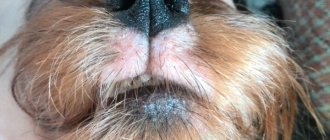Itching in a dog is an unpleasant phenomenon, accompanied by severe scratching. It is not an independent disease, but only acts as a symptom, warning about the danger. If your pet constantly scratches its body, then without timely help it will tear off its skin. Numerous injuries will lead to secondary infection and aggravate the existing problem.
How does itching appear in dogs?
It's quite easy to suspect something is wrong. The dog constantly itches and chews itself in a certain area or throughout the body. Due to unpleasant sensations, she sleeps poorly and refuses games and favorite treats. Appetite decreases, which quickly affects weight. The hair gradually falls out until some areas become completely bald. The skin becomes red and inflamed.
The probable cause of itching in a dog can be determined by its location. Active scratching of the ears indicates a high probability of otodectosis. If your pet rubs all parts of its body against furniture and rolls around on the floor, it may suffer from a skin disease or an allergic reaction. Regardless of the cause, treatment is carried out only after diagnosis in a veterinary clinic.
Allergic reaction to various irritants
If your dog is constantly itching and testing for fleas and other parasites is negative, you may suspect an allergy caused by the following factors:
- flea bites;
- substances entering the body by air;
- chemicals from hygiene products;
- food or its change;
- vaccines and vaccinations.
The human and dog bodies are very different and, despite the fact that the allergic components are similar and their mechanism of action is the same, the symptoms are different. In dogs, allergies are prolonged by itching and skin disorders. Subsequently, a secondary infection takes root at the site of severe scratching, which is accompanied by inflammation.
Fleas cause allergies, which is the body's reaction to a foreign protein that enters the bloodstream with the secretions of the insect's salivary glands. Even one flea caught on a dog can cause an allergy in the animal that once suffered from fleas.
Atopic dermatitis, which doctors estimate affects 4 to 16% of dogs, is caused by:
- plant pollen;
- household dust;
- excrement and particles of chitinous cover of synanthropic insects;
- mold fungi;
- dead particles of the epidermis;
- bird feathers and down.
Atopic dermatitis in dogs
The dog often itches, especially in the area of the toes, belly, tail, and back. Red spots form under the fur, which are easy to notice, especially in short-haired dog breeds.
Food allergies are caused by proteins (anaphylaxis) or non-protein components of food (atopy). It is necessary to distinguish between intolerance to certain foods and true allergies, therefore, only a specialist can decide how to treat a food allergy after a differential diagnosis.
Allergens
Allergies in dogs are most often caused by products such as horse meat, beef, and milk. The second group of allergenic products are soy, chicken, and lamb. Many premium foods contain these products. The allergy is accompanied by such severe itching that the dog itching, biting these places, can completely erase the incisors.
We invite you to read: How to remove bedbugs from an apartment, sofa and clothes at home? How to get bed bugs out of your apartment forever?
https://www.youtube.com/watch?v=upload
In long-haired dogs, an allergic reaction provokes the development of a severe form of dermatitis. If the Pekingese itches, and on parts of the body the fur is noticeable, sticking together, as if from saliva, then the cause may be wet dermatitis. When cutting the wool, a very complex picture of pathology becomes visible.
Allergies can be triggered by the use of medications - eye and ear drops, vaccines, etc. The manifestations are the same as with other types of allergies. If your dog itches after taking flea drops, then it is highly likely that he is allergic to this product.
Dermatosis, which is accompanied by itching, can be caused by contact with the collar. This form of the disease is often observed in puppies, since their delicate skin is very sensitive to constant exposure to insecticides. The puppy is itching, trying to remove the collar.
To treat allergic reactions, veterinarians prescribe cortisone and other antihistamines that help relieve skin manifestations and itching (Benadryl, Tavist, Amitriptyline, Atarax).
Diagnosis and identification of the cause
Using medications before diagnosis can distort test results. Veterinarians recommend avoiding self-medication and seeking help immediately after an alarming symptom appears.
After a visual examination and history taking, the veterinarian performs the following diagnostic tests:
- stool and urine analysis;
- clinical and blood biochemistry;
- skin scraping, as well as scraping of secretions from the affected areas;
- allergy tests;
- Ultrasound and X-ray.
If there are symptoms of a fungal infection and negative results of basic tests, additional tests may be required. The most popular diagnostic method for this disease is the Wood's lamp.
Parasitoses
Most often, itching in a dog occurs when infected with external parasites. This is due to lack of timely processing.
Fleas
Flea infestations cause an allergic reaction to the parasites' saliva. It contains a foreign protein that is rejected by the body of an infected animal. If there is a severe infestation of blood-sucking insects, you can notice them yourself. They look like small black or brown grains.
Despite the species classification based on the final host, fleas quickly adapt and can feed on the blood of any animal, including humans. The most dangerous species is the rat. These parasites are more likely than others to carry dangerous infections. A bitten dog can become infected with rickettsiosis, helminthiasis, endocarditis and other diseases.
Ticks
It is possible to find out why a dog itches if it does not have fleas by observing the accompanying symptoms. Tick-borne infestations are characterized by yellowing and severe peeling of the skin, as well as the formation of purulent inflammations. With otodectosis, dark brown discharge forms in the ears, and the sick pet constantly shakes its head.
Infection with subcutaneous mites is fraught with problems with the lymph nodes, kidneys, stomach, spleen and liver. Due to numerous wounds, the risk of death from sepsis increases. Once a secondary infection occurs, the chance of recovery is only 50%.
Like fleas, ticks carry infections. An infected person may suffer from hepatozoonosis, ehrlichiosis, bartonellosis or piroplasmosis.
lice eaters
Lice eaters are the closest relatives of lice, resembling white grains of dandruff and characterized by a quadrangular head shape. They feed on particles of fur and skin, causing severe itching in the dog. Most often, the symptom of infection occurs at the base of the tail, ears, belly or thighs. The affected skin becomes rough and thickened. The condition of the coat is deteriorating. Bald patches form.
Puppies can become infected from a sick mother. In addition to the listed symptoms, the presence of lice in young animals can lead to developmental delays. Also, these parasites often carry helminth eggs, which is especially dangerous for pets under 1 year of age.
Skin diseases
Owners often do not understand what to do if the dog is itchy all the time, but it does not have fleas or other parasites. The fact is that parasitosis is only one of the possible causes. The symptom may also occur due to allergies, exposure to high or low temperatures, fungal or bacterial infections, or malfunction of the exocrine glands.
Allergy
Increased sensitivity to certain irritants causes the dog to experience itching, peeling of the paw pads and redness of the interdigital area. Watery discharge appears from the eyes and nose, and swelling and rash appear on the skin. Diarrhea and excessive sweating may occur, which can be easily detected by a damp sleeping area.
Allergic reactions in four-legged pets are more severe than in humans. They get worse with age, so it is recommended to stop attacks immediately after they occur.
Irritation from cold or heat
Overheating and frostbite injure the skin, so the animal constantly licks itself. This leads to the development of acral dermatitis - compulsive licking, leading to the formation of dense ulcerations and tissue death. This disease causes severe intoxication and is difficult to treat. Heat can also cause itchy pyoderma and even cancer.
Fungus (lichen)
The most dangerous fungal infection is ringworm. It is caused by fungi of the genus Microsporum. A sick dog constantly scratches its hind legs, neck and head. As the disease progresses, the fungi spread to the back and eventually affect the entire body. Infected skin develops circular redness, dry scabs and bald areas with well-defined borders.
Bacterial infection
Skin diseases are often caused by bacterial infections. The most common causes of pathology are streptococci and staphylococci, which cause pyoderma. This disease is accompanied by the appearance of erosive and ulcerative formations, purulent papules and skin inflammation. The patient's body becomes covered with dandruff and begins to emit a pungent smell of rot. The dog itches and bites the itchy areas, becoming weak and lethargic.
The hips, anus and base of the tail are primarily affected. The affected areas become covered with a rash, and their temperature rises. When touching the inflamed areas, the pet experiences a feeling of pain. Without treatment, inflammation spreads to neighboring areas, which can lead to necrosis and sepsis.
Hyperfunction of the sebaceous glands
Hyperplasia of the sebaceous glands, or sebaceous tail, occurs due to a disruption of the secretory function. The exact cause of this pathology has not been identified, but veterinarians identify several predisposing factors:
- lack of regular skin and coat care;
- the presence of other skin diseases or allergies;
- being kept in poor conditions and having a poor diet;
- sudden decrease in immunity.
Itchy sensations appear near the anus and at the base of the tail. Blackheads, redness, lumps and dandruff appear in these places. The fur begins to stick together and fall out.
Allergies
An allergy is a reaction of the immune system to a substance that in itself does not pose a serious threat to health. Most often, allergies in dogs occur due to low-quality food or to certain types of food (for example, chicken).
One of the symptoms of an allergic reaction in a four-legged friend is itchy skin. In some cases, scabies is characterized by hair loss in the irritated area.
Allergies cannot be cured. The only way to avoid an inadequate reaction of the body is to keep your pet as far as possible from the irritant. With a natural diet, the allergenic product is excluded from the diet.
If you are allergic to dry food, then choose a safe one with the help of a veterinarian, since it is not obvious which component the body reacts to with itching.
It is important! You cannot treat allergies on your own. A course of therapy will be prescribed by a qualified veterinarian after a full examination.
Other reasons
The remaining causes are associated with psychological and internal disorders, as well as inflammation of the anal glands - small sacs with secretions that allow animals to distinguish each other by smell. With frequent inflammations, four-legged patients have to regularly visit the veterinarian for preventative cleaning of the glands. You can also learn this on your own.
Past stress
Constant scratching may be due to severe stress. It occurs due to experiences associated with moving, changing owners, having new family members, traveling by car, going to the veterinary clinic or grooming. If the animal’s condition returns to normal after a couple of hours or a day, then the stress is considered short-term and does not require medical intervention. In other cases, the resulting disorder is considered chronic. Without treatment it will only get worse.
Symptoms of mental disorders may include:
- mood swings;
- prolonged licking until the formation of bald patches;
- refusal to execute commands;
- excessive intrusiveness or desire for privacy;
- gnawing fur and biting the body;
- slight trembling and drooling;
- running in circles accompanied by barking or squealing;
- the emergence of interest in inedible objects;
- digging holes contrary to the owner's prohibitions.
Feeling changes in its body, the pet tries to get support and help from a person. To do this, he can spoil your favorite things and defecate directly on the floor. If your pet is well-bred, then such sudden changes are a serious reason to contact a veterinarian.
Diseases of internal organs
Itching in a dog is one of the symptoms of diabetes, endometritis, liver and kidney failure. Ultrasound and x-rays are used to identify pathologies of internal organs. These studies help determine the exact area and extent of its damage.
Inflammation of the anal glands
The anal glands are located just behind the entrance to the anus. The secretion they contain allows them to mark territory during bowel movements. When these pouches become inflamed, the dog rolls on its butt, bites its tail and licks the anus.
The cause of the inflammatory process is denser stool or clogged glands. This interferes with the natural release of secretions and leads to stagnation.
Treating the root cause
The main goal of treatment is to eliminate the root cause. Symptomatic therapy is carried out in combination. Depending on the diagnosis, the following treatment options are offered:
- Parasitoses
. The four-legged patient is prescribed insecticidal drugs (Spregal, Anandin, Frontline) that destroy the causative agent of the disease.
- Allergy
. Allergic reactions are suppressed with antihistamines (Suprastin, Tavegil, Diphenhydramine). Food allergies are blocked with a therapeutic diet that excludes allergenic foods, or with therapeutic hypoallergenic food.
- Irritation from cold or heat
. Secondary infections are suppressed with antibiotic therapy and glucocorticosteroids. Damaged areas are restored with anti-inflammatory ointments with a healing effect.
- Fungal and bacterial infections
. Eliminated with antibiotics and antifungal drugs. An animal with lichen is isolated in a separate room to prevent infection of other family members.
- Hyperfunction of the sebaceous glands
. It is treated with antibiotic therapy and treatment of inflamed areas with antiseptics.
- Stress
. The animal is protected from irritating factors or gradually accustomed to them. The veterinarian may also recommend taking sedatives (Fitex, Stop-Stress) or collars with pheromones that reduce anxiety.
- Diseases of internal organs
. Treatment focuses on repairing the damaged organ.
- Inflammation of the anal glands
. In case of severe inflammation, the veterinarian prescribes a course of antibiotics and suppositories. In other cases, the stagnant secretion is released by manual stimulation.
If the dog itches, then bathe it more often, relieving inflammation with the help of special shampoos. For faster healing, the affected areas are lubricated with linseed oil. For the same purpose, it is recommended to use decoctions of oak bark, birch leaves, oat grains and strawberry roots.
Ectoparasites
Insects that parasitize animals include not only fleas, but also other arthropods - ticks, lice, lice.
Tick, louse, lice eater
After treating your pet for fleas, you cannot be completely sure that you managed to get rid of them. After all, flea eggs and larvae can remain on the dog’s bedding, in furniture upholstery and carpets. Therefore, you should once again examine the dog’s fur to identify eggs and adult fleas.
If the dog itches, but there are no fleas, it is worth examining the skin for the presence of other insects:
- mites: ixodid, gamas, subcutaneous (demodex), scabies, ear mites, etc.;
- lice eaters.
The Ixodid tick causes diseases such as piroplasmosis, ehrlichiosis, hemobartonillosis, and Lyme borelliosis. The secretion of the salivary glands of mites causes severe itching and scratching in dogs in the neck, ears, and head. There can be an allergic reaction to a tick and flea bite, which leads to rashes and itching. The dog itches all the time, causing damage to itself. Only a veterinarian can describe how to treat an animal for piroplasmosis.
The gamas mite parasitizes small animals (mice, rats) and birds (chickens, pigeons). The parasite can migrate to the dog's torso if there is no usual host nearby.
The subcutaneous mite is capable of parasitizing on the surface of the epidermis for a long time, feeding on horny scales. When immunity decreases, the mite penetrates deep into the skin, causing severe itching. The female lays eggs in the hair follicle, which becomes inflamed, forming a characteristic red rash. Demodicosis is most often noted on the dog's face. Itching causes scratching and red spots on the nose, around the mouth and eyes.
We suggest you read: Lice in a child - what to do, treatment and reviews
The scabies mite, which is called itching due to the symptom accompanying the infection, provokes scabies.
Subcutaneous mite
Ear mites parasitize the ears of cats and dogs, feeding on the secretions of the sebaceous glands and wax. Temporarily, until it gets into the ear canal, the insect can be on any part of the body, gnawing passages in the skin to get to the lymph. The affected area begins to itch very much, so the dog shakes its ears and begins to scratch them vigorously.
Any type of mite has symptoms both characteristic of a particular species and common to all, among which the main one is itching. Treatment includes local and systemic drugs. The complex is prescribed only by a veterinarian; self-medication can lead to serious consequences.
But infection with ticks, lice and fleas can be prevented by treating the dog with one of the medications in the form of spray Bars, Bolfo, Frontline, Defendog). The drops have proven themselves well.
https://www.youtube.com/watch?v=ytpress
It is also recommended to put a collar on the animal (Kiltiks, Foresto, Celandine). Products for dogs











